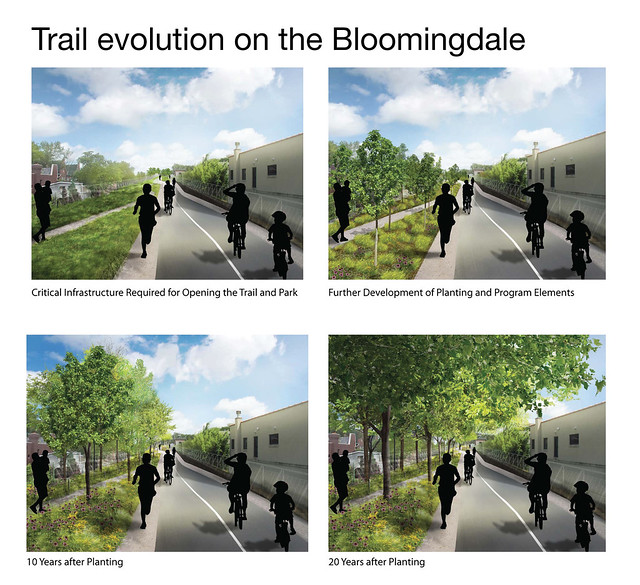The High Line in New York City has been lauded for transforming abandoned freight rail tracks into an elevated walking path and park on the west side of Manhattan, but The Bloomingdale (formerly known as Bloomingdale Trail) will be even better. This is simply because the High Line acts as a tourist attraction, while The Bloomingdale will serve as a neighborhood park in areas that sorely need more green space, and a very useful car-free transportation link for people walking and biking.
I took journalist David Lepeska on a tour of the Bloomingdale back in January. We climbed up the embankment in Julia de Burgos Park, then we walked all the way to Damen and perhaps even a bit further.
David described our journey in a piece for Next City's "Forefront," a digital subscription publication. (You can buy each issue for $1.99, and I highly recommend it.)
David's article makes the point that the High Line is more of a destination to see than a place to use: "Visitor surveys in New York show that people generally do not use that park to go from point A to point B, and that more than half come to the West Side expressly to visit the High Line."
At a fundraiser in January, David reports, Chicago Deputy Mayor Steve Koch shared this perspective on the difference between the two projects:
"A lot of people are familiar with the High Line. This is a concept far beyond that truly transformative project." ...
"This is the High Line on steroids," Koch continued, relaying how his boss, Mayor Rahm Emanuel, vowed to complete the Bloomingdale in his first term. "I think he was captured by this extraordinary vision. This was a chance to create this ribbon of green that transforms our industrial legacy, a chance to take that and bring it into the 21st century as this incredible urban green space."
David also examines other cities looking to convert abandoned railways into parks and transportation links, including London, Rotterdam in the Netherlands, and Wuppertal, Germany. The Bloomingdale, he writes, will test the theory of why cities are building these amenities:
“Cities have really become aware that they are competing with each other for the businesses and well-educated mobile citizens that make cities work,” said [Will] Rogers [president and CEO of Trust for Public Land]. “These people get to choose where they want to live, and they tend to choose green, walkable cities with great neighborhoods, great parks, good cultural institutions. I think the reason cities are investing in these opportunities is that they are really trying to position themselves to attract these people."
However, as I told David, the higher property values that will benefit the city in the form of increased tax revenues should be seen as secondary to the real benefit: The Bloomingdale will be "an asset these neighborhoods have needed, and a safe route to walk and bike."
You can get the whole article on Next City and see more images of the Bloomingdale Trail, present and future, on Flickr.






